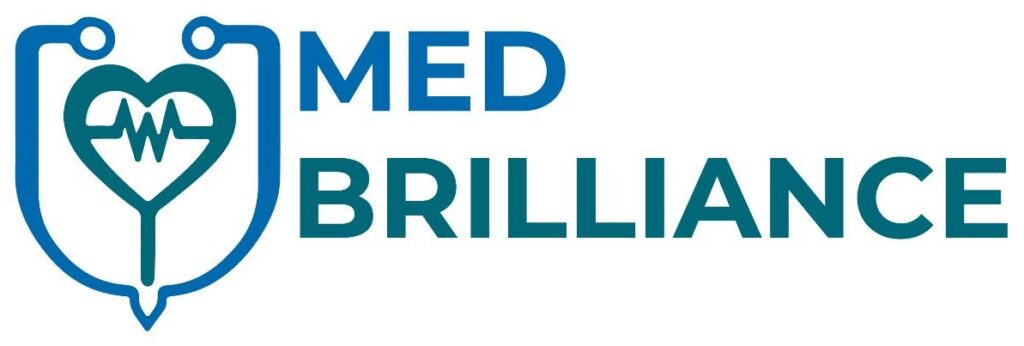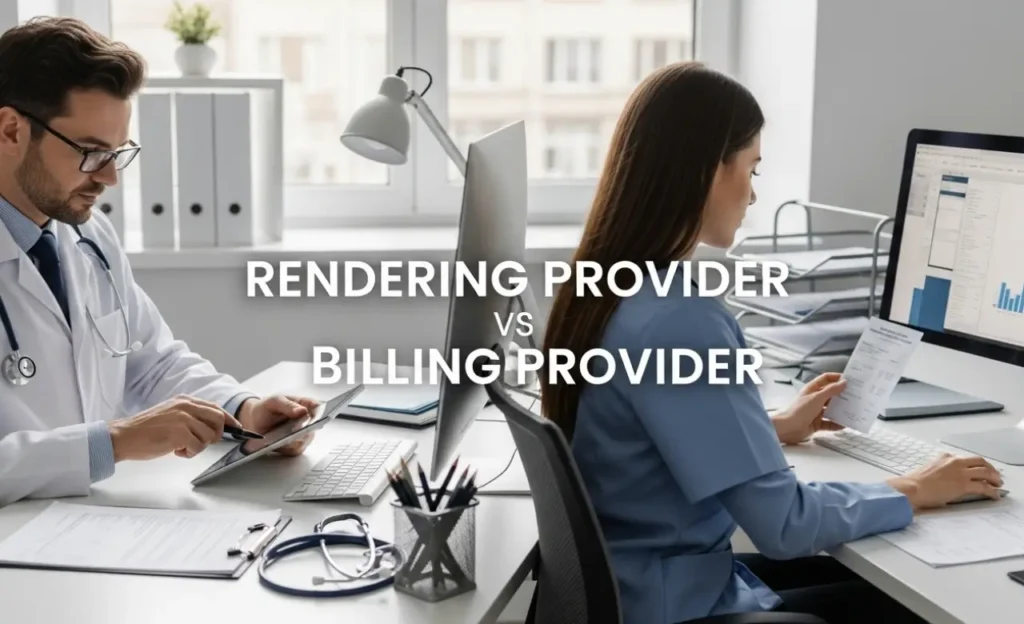The complete understanding of the roles of rendering providers and billing providers is essential for healthcare professionals, practice managers, and medical billing companies like MedBrilliance. These roles affect reimbursement, claim accuracy, and compliance with insurance requirements. If you’re managing a healthcare practice, Medical coding or medical billing workflow, then this information is very critical to select the right provider according to requirements.
Comparison Between the Rendering Provider vs Billing Provider
Here is a quick overlook of the key differences between the rendering provider and the billing provider:
General Comparison
Rendering Provider
Billing Provider
Performs the medical service
Submits the claim for the performed service
Must be a licensed healthcare professional
Can be a person or entity (e.g. group practice)
Name appears as the service provider on the claim
Name appears as the payee on the claim
NPI Type 1 required (individual)
NPI Type 2 often used (organization)
Associated with clinical care
Associated with claim processing
Functional Differences
Diagnoses and treats the patient
Handles insurance claim submission and follow-up
Enters notes in the patient’s EHR
Checks claims for coding accuracy
Provides telehealth or in-person care
Manages billing software and clearinghouse setup
Signs off on charts and documentation
Responsible for filing claim using the correct NPI
Must follow coding guidelines (CPT, ICD-10)
Guarantees proper claim batching and timeline adherence
Legal & Compliance Differences
Must hold a valid state license
Must comply with HIPAA and payer rules
Required to enroll with payers (Medicare, Medicaid, etc.)
May need to sign payer contracts if receiving direct payment
Can be audited for medical necessity
Can be audited for billing compliance
Responsible for clinical documentation
Responsible for correct claim submission and patient billing
Subject to malpractice laws
Subject to False Claims Act if fraudulent billing occurs
Operational Differences
Seen on the encounter level in EHR
Seen on the claim level in billing software
Appears in patient care reports
Appears on remittance advice (EOB/ERA)
One claim can have multiple rendering providers
One billing provider per claim
Work is tracked for performance and productivity
Work is tracked for claim success rates
Often the provider is unaware of billing intricacies
Must stay updated on insurance payer changes
Need Experts Help?
Get free consultation from our specialists and find the right solution.

Roles & Responsibilities of a Rendering Provider
These tasks are specific to the individual healthcare professional providing direct patient care:
- Performs the face-to-face or virtual medical service during the patient visit.
- Documents patient symptoms, history, diagnoses, and treatment plans accurately.
- Selects appropriate CPT and ICD-10 codes for every service delivered.
- Signs off clinical documentation to confirm service delivery.
- Maintains all relevant state licenses and board certifications.
- Participates in payer credentialing and re credentialing processes.
- Complies with HIPAA and patient privacy regulations during documentation.
- Reviews lab results, imaging, or referrals connected to the patient’s care.
- Follows insurance-specific clinical guidelines (e.g., Medicare LCDs).
- Responds to audit requests related to clinical care or medical necessity.

Roles & Responsibilities of a Billing Provider
These tasks are managed by the entity or individual responsible for submitting and managing insurance claims:
- Submits claims to insurance payers using the correct billing provider NPI and Tax ID.
- Manages claim rejections, denials, and resubmissions within payer timelines.
- Verifies patient insurance coverage and prior authorization requirements.
- Reviews clinical documentation to ensure coding and billing alignment.
- Uses billing software or clearinghouses to manage electronic claim flow.
- Ensures compliance with CMS, HIPAA, and payer billing regulations.
- Tracks payments, posts remittances, and reconciles EOB/ERA data.
- Prepares and mails patient statements when insurance doesn’t fully cover.
- Coordinates with rendering providers for missing or incorrect documentation.
- Maintains up-to-date payer rules, fee schedules, and credentialing files.
How to Choose Between a Rendering or Billing Provider Role
Choosing the correct designation makes sure that correct payment, compliance, and smoother claim processing are covered according to your requirements:
1. Choose Rendering Provider if You Deliver Care
You must select this if you’re providing hands-on medical services to patients. This applies to physicians, nurse practitioners, therapists, or any licensed healthcare provider.
2. Choose Billing Provider if You’re Submitting Claims
This is required if your role or business is to submit claims for reimbursement. The billing provider gets the payment and is responsible for all claim follow-up.
3. Use Both Roles in Group Practices
The individual doctors are rendering providers and the group entity is the billing provider in medical service. This is common in multi-specialty or hospital-affiliated practices in the USA.
4. Use Rendering Only for Direct Payment
If you’re a solo provider getting paid directly then you often act in both roles. Medicare and Medicaid require accurate designation of both when applicable.
5. Billing Provider Must Match Tax ID for Reimbursement
Select the billing provider based on whose Tax ID will receive payment from insurers. Incorrect setup may result in claim denials or payment delays from the clearing house.
6. Consider Rendering Role if Audits Involve Clinical Documentation
Rendering providers are responsible during clinical audits for showing medical necessity. Make sure that your documentation supports each billed service to reduce compliance risks.
7. Choose Billing Role if You Operate a Third-Party Billing Service
If you’re a medical billing company then you need to enroll as the billing provider and not the rendering provider. You must stay updated on insurer rules, NPI linking, and remittance setups.
8. Choose Based on EHR and Billing Software Integration
Your choice should align with how your systems assign NPIs and generate claims. Some platforms automatically pull billing or rendering info based on provider setup.
Get a free consultation from certified Billing specialists.
Visit our Medical Billing page to learn more about our solutions.
FAQs
1. Can the rendering provider and billing provider be the same person?
Yes, when a solo physician both treats patients and bills directly then they act as both rendering and billing provider.
2. Whose NPI goes on the claim: rendering or billing provider?
Both NPIs may appear. The rendering provider’s NPI shows who gave care, while the billing provider’s NPI shows who gets paid.
3. Why is it important to list rendering and billing providers correctly on claims?
Accurate listing prevents claim denials, guarantees proper reimbursement and keeps your practice compliant with insurance rules.
Check out our latest research on medical billing in the MedBrilliance collection of Medical Billing Research Articles.
We strictly follow all standard medical billing protocols and you can learn more about medical billing services through Wikipedia



